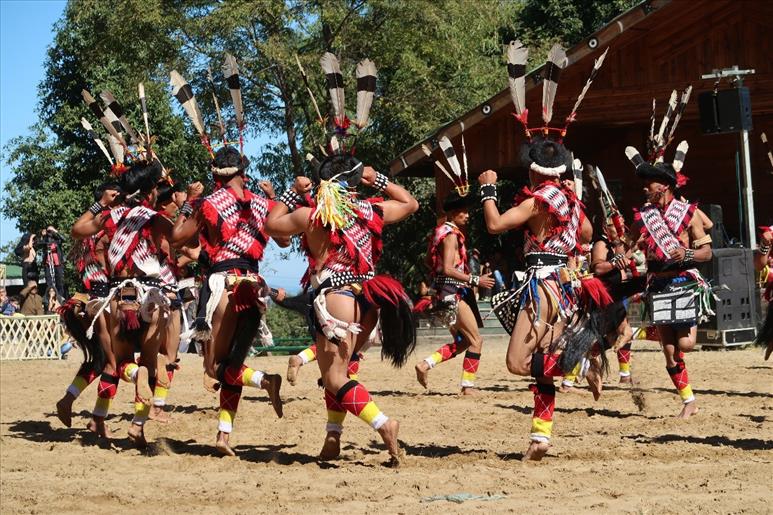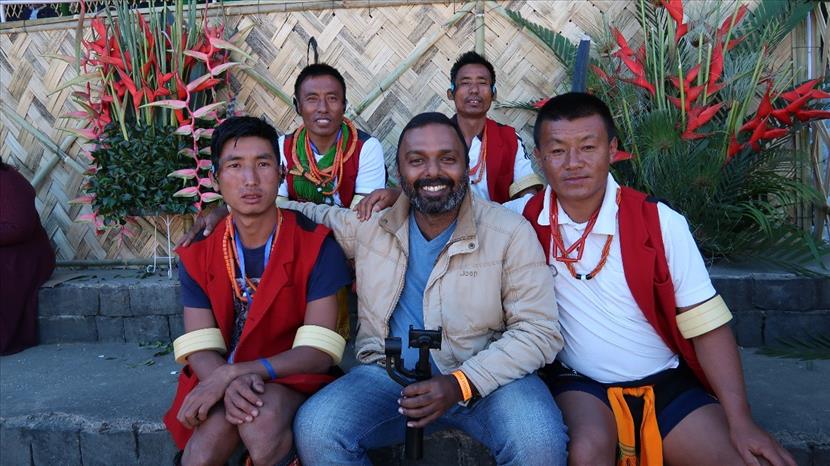Article /
Arts,Crafts & Culture /
Festival
Cultural Extravaganza in the Festival of Festivals |
| |
|
By
Ebin Jose
https://www.webindia123.com/user_interaction/asp/view_profile.asp?login_id=18532
12.2.2018
Image
Phone:-
Mail Now
Send Mail
Post Comments
|
|
|
Chill weather and freezing winds of Nagaland did not stop
the flow of tourists to this spectacular venue on top of the eastern himalayas
near Kohima. Once again Kisama heritage village in Nagaland groomed herself in
vivid colours yet conserving the traditional values. Every year, in December,
the village adapt itself to welcome guests from all around the world. The
festival that is famous as the ‘festival of festivals’ is organized by the State
Tourism Department in collaboration with the Art & Culture Department during the
first 10 days of December.
Though hornbill is not the state bird of Nagaland, the festival is named after
the colourful Great Indian Hornbill, which is portrayed in many of the Naga
folktales.The tribesmen of Nagaland believes that the bird represents their
tradition and its musical cries keeps the integrity between their tribes.
Our journey began on 20th November of 2017 to witness the cultural extravaganza
in the courtyard of Nagaland - Kisama Village. Though we aimed to reach our
destination on 1st of December, the minor obstacles on our way delayed our
arrival by two days.
The capital of Nagaland - Kohima, in fact a smaller town comparing to Dimapur -
the largest city of the state, was overflowing with tourists. Even the
homestays organised within the heritage village were not sufficient for many to
find a space within. Thanks to Rev. Fr. T S Varghese and his friend Mr. Baby who
arranged our stay in a hotel in Dimapur. From Dimapur Kisama village is
approximately 76 kilometers, after Kohima.
As we reached the Kisama hills, on the third day morning, the tribesmen of
Nagaland were walking out from the main venue in two rows to receive that day’s
chief guest. We were thrilled to see them in their traditional attires. Mostly
their dresses were just enough to cover their nudity, but not sufficient to
protect them from the early winter’s intensity. Yet, they followed the
traditional norms - so vivid and splashy.
It took almost an hour to welcome the guests in their classical manner, but as
the tribesmen started performing to the rhythm of tribal musics, the village
turned lively. Cameras clicked and people applauded in appreciation. I found a
small place close to the amphitheater and stood on my knees through the
performance, for not to miss any moment from those thrilling dancers. They
danced to represent farming, harvesting, war, hunting, and even a detailed
feast. Wrestling being the part of Naga culture, they also demonstrated an act
in front of the guests.
After the morning digest, we went around the heritage village to explore various
tribal huts with their cultural exhibits. We started off with the Chakhesang hut
where I tried tasting a ground chutney from sesame seeds, mustard seeds, ginger,
and garlic. The penetrating flavour of the chutney surely tickle my tongue.
Among the favourite cuisines of Nagaland included roasted pork, deep fried pork,
smoke fried meat, smoke fried dog meat, pork and snail soup and hot salad.
While I enjoyed the smoke fried pork, I did not try dog meat. However, the deep
fried pork with Ao tribe rice and rice beer made my lunch so delightful. After
such a rich lunch, like most other tourists, we too posed with the local people
to take a couple of snaps.
Furthermore, to edge an adventure during our hornbill
festival eve, I tried my hands on an old model double barrel gun.
Unlike in the south and west, in Nagaland, sun sets by
around 4:30. A group of youngsters fixed a few campfires that offered the needed
warmth and comfort. On the center stage a musical troupe sung and danced carol
songs announcing the arrival of Christmas. With a glittering sky above us and a
soothing music in our ears, we drove back to Dimapur holding on to the hued
memories of Hornbill Festival.
TAGS:
Hornbill festival,
Kisama,
Nagaland festivals,
,




